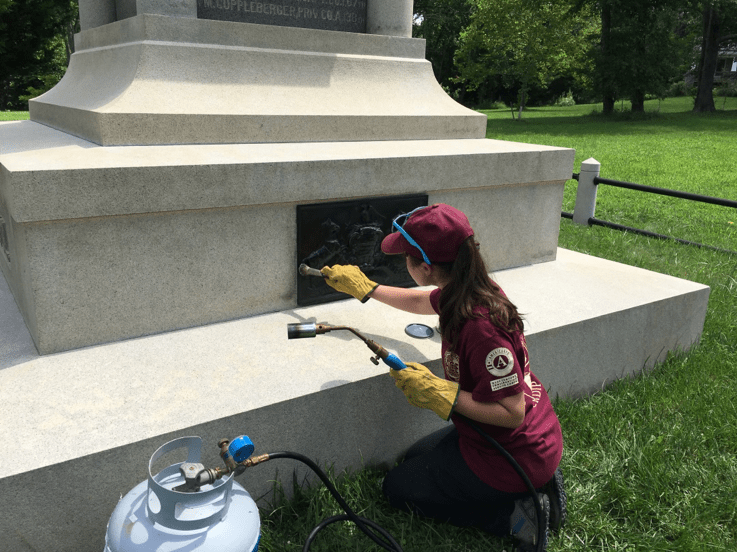It’s Not “Goodbye,” It’s “See You Later”!
by: Mariah Walzer
I can’t believe that it’s been ten weeks since I first saw the rolling fields of Monocacy National Battlefield. Time has flown by so fast! Unfortunately, the rain on that first day was a foretaste of things to come, weather-wise, but not even this summer of flooding can dampen my love for this park and the people I’ve met here.
Battlefields may not be known for their natural beauty, but amidst the hustle and bustle, concrete buildings and skyscrapers, of industrialized and commercialized America, I find great beauty in the corn fields and historic buildings. Monocacy NB feels like this little piece of tranquility just south of busy Frederick, Maryland. And the sunsets… oh the sunsets! Whoever decided to make the building I lived in seasonal housing definitely wanted the occupants to stick around. I could sit on my porch in the evenings and watch the sun fade into brilliant colors beyond the mountains and a historic barn. What more could you ask for?
Great coworkers, you say? Well, I got lucky with those too. My mentor, Alex, and supervisor, Andrew, were always interested in my thoughts and ideas, sought to make sure I got the most out of this internship I could, and have been a great resource already in furthering my career. So many other people, both at Monocacy NB and in the National Capital Region, welcomed me into the Park Service family as well.
My parents always said that the National Park Service was full of “odd ducks.” They meant that Park Service life attracts a special type of person: people who are generally willing and excited to interact with visitors on a daily basis regardless of their formal position, to move around the country, to live and work in a variety of landscapes, and to work with people from many diverse backgrounds towards the shared goal of preserving this country’s natural and cultural resources. Not everyone is cut out for Park Service life – it’s not always as glamorous as many people think – but after this summer, I’ve decided I want to give it a try for real someday.
I came into this internship with big question marks in my life plan – I knew I liked archaeology and I loved educating people about the past, but I didn’t know what that would look like as a career. I left with a new goal: to wear the green and gray NPS uniform. And I have a pretty good idea of how to get there!
As to my actual work, I rounded out my summer at Monocacy with my favorite activity: talking to people about archaeology! Among other small projects, I spent my last two weeks finishing up the educational presentations I’ve been writing about. In addition to putting the finishing touches on my PowerPoint slides, I also catalogued the Interpretive Division’s collection of educational Civil War artifacts. Identifying buttons and bullets was a whole new ball game for me, but I dove head first into the challenge and thoroughly enjoyed it! There’s no greater rush in archaeology than pinpointing exactly what an artifact is, where it came from, and when it was made and used.

This canteen has a stamped inscription on the neck that identifies the manufacturer and date. It was made in Philadelphia in 1864, under the new style requirements for US military canteens (the concentric rings).

What does one do when one knows next to nothing about Civil War artifacts? Raid the bookshelves, of course!

I was pretty proud of myself for identifying this time fuse that was used to delay cannon shell explosions. This one has certainly been fired.
I also finally got to finish cleaning and conserving the Pennsylvania Monument (we got rained out part way through the project in June). I learned about using patina and waxes on bronze plates, which was pretty cool!

Painting the chemical for patination (color change) on the oxidized (greenish) areas of the bronze plaque.

A layer of hot wax is applied to protect the plaque by heating the bronze with a torch and then brushing on the wax, which melts in the heat.
I stuck around an extra day in order to give my presentation a test run. Monocacy NB hosted an Infantry Day on August 11th in which reenactors gave demonstrations of infantry firing techniques for the enjoyment and education of the public. I jumped in to talk about archaeology at Monocacy NB, trading off every other hour with the reenactors. I generally had ten to twenty people for each session, and people seemed very interested. Most people never realized that the land had been occupied for over 10,000 years! I really enjoy getting to challenge and add to people’s understanding of a place. As I’ve talked about before, archaeology’s greatest strength and purpose, in my opinion, is in telling the untold stories.
The Interpretive staff was very happy with the public reception, and I was just happy to have the opportunity to geek out about the things I love. It was a perfect end to a great summer!






